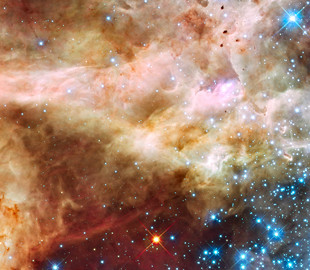As part of the largest and one of the most ambitious programs of the Hubble space telescope, a team of scientists and engineers collected information on almost 500 stars for three years. This work allows a new look at the formation, evolution and impact of stars on the environment.
The comprehensive study, named ULLYSES ( Ultraviolet Legacy Library of Young Stars, as Essential Standards ), was completed in December 2023 and is a rich set of spectroscopic data obtained in ultraviolet light that astronomers will use for decades to come. Because ultraviolet light can only be observed from space, Hubble is the only telescope in operation capable of conducting these studies.
“I believe that the ULLYSES project will be revolutionary and impact all of astrophysics, from the study of exoplanets, the influence of massive stars on the evolution of galaxies to understanding the earliest stages of the universe,” says Julia Roman-Duval, ULLYSES project leader at the Space Telescope Science Institute (STScI) in Baltimore, Maryland. “In addition to the specific goals of the program, data about stars can be used in other fields of astrophysics that we cannot yet imagine.”

The ULLYSES team studied 220 stars and then combined these observations with information from the Hubble archive on another 275 stars. The program also included data from the largest and most powerful ground-based telescopes and X-ray space telescopes. The ULLYSES dataset consists of stellar spectra that carry information about the temperature, chemical composition, and rotation of each star.
One of the types of stars studied by ULLYSES is super-hot, massive, blue stars. They are a million times brighter than the Sun and glow fiercely in ultraviolet light that is easily detected by Hubble. Their spectra contain key data about the speed of their powerful winds. Winds control the evolution of galaxies and lay in them the elements necessary for life. These elements are cooked in the nuclear fusion furnaces of stars and then ejected into space when the star dies. ULLYSES targeted blue stars in nearby galaxies that lack elements heavier than helium and hydrogen. This type of galaxy was common in the early universe. “The ULLYSES observation – is a stepping stone to understanding those first stars and their winds in the Universe, and how they influence the evolution of the young host galaxy,” – says Roman-Duval.
Another category of stars in the ULLYSES program – young stars less massive than our Sun. Although they are cooler and redder than our Sun, during their formation they emit streams of high-energy radiation, including bursts of ultraviolet light and X-rays. As they are still growing, they collect material from the surrounding planet-forming disks of dust and gas. The Hubble spectra include a key diagnostic of the process by which they acquire their mass, including the amount of energy released into the surrounding planet-forming disk and environment. The radiation of young stars in the ultraviolet range affects the evolution of these disks as planets form, as well as the probability of habitability of newborn planets. The target stars are located in the nearby star-forming regions of our Milky Way galaxy.
The ULLYSES concept was developed by a committee of experts to use Hubble to provide a legacy set of star observations. Initially, ULLYSES was conceived as a program of observations using Hubble's sensitive spectrographs. However, the program has been greatly expanded through coordinated community and complementary observations with other ground-based and space-based observatories,” says Roman-Duval. “Such broad coverage allows astronomers to study the lives of stars in unprecedented detail and to build a more complete picture of the properties of these stars and how they influence their environment ” .

